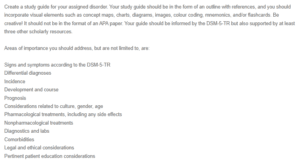Study Guide For Attention Deficit Hyperactive Disorder (ADHD)
Signs and Symptoms According to the DSM-5-TR
Attention Deficit Hyperactive Disorder (ADHD) is a psychiatric illness associated with significant cognitive and functional deficits. Persons with this disorder demonstrate patterns of developmentally inappropriate levels of impulsivity or hyperactivity and inattentiveness. The signs and symptoms of the disorder include lack of concentration, inattentiveness, difficulty finishing tasks, forgetfulness, ease of losing things, and disorganization. As per the DSM-V diagnostic criteria, these symptoms must have been present for at least six months and interfere with the activities of daily living (Diagnostic and Statistical Manual of Mental Disorders: DSM-5-TR, 2022).
ADHD-A disorder of impulsivity
Differential Diagnoses
Several disorders have a similar presentation to ADHD. The differentials in ADHD include depressive and anxiety disorders, substance use disorders, and developmental disorders such as autism spectrum disorders. Mood disorders can be misdiagnosed in a patient with ADHD due to their potential to cause memory loss, inattentiveness, and distractibility. Substance abuse disorder can also result in memory impairments.
Incidence
ADHD remains a common illness among children. The combined type accounts for over 70% of the cases. The incidence of any form of ADHD currently stands at between 5 and 7.2% among children and adolescents and between 2.5% and 6.7% in the adult population (Salari et al., 2023). In the U.S., the incidence stands at 3.3 million children.
Development and Prognosis
ADHD has been associated with functional and cognitive deficits. Persons with the disorder will have goal-directed cognitive deficits. The disorder may persist after adolescence and affect a person’s social and academic domains. Other people have been shown to grow out of the disorder as they return to normal functioning as they age. If left unmanaged, the prognosis of ADHD is worse as it may cause persistent dysfunctionalities with consequent increases in car accidents, substance use behaviour, job losses, and inability to work.

Considerations Related to Culture, Gender, Age
Further, ADHD affects all populations. The disorder is, however, more prevalent among the child population. It affects all cultures with no specific cultural preferences. Notably, ADHD disorder has a higher prevalence in males compared to females.
Pharmacological Treatments and Nonpharmacological Treatments
Comprehensive management of ADHD utilizes pharmacological and non-pharmacological interventions. Pharmacotherapy is the mainstay modality for managing ADHD. Anti-ADHD medications consist of stimulants such as amphetamine and non-stimulants such as atomoxetine and guanfacine (Drechsler et al., 2020). These medications maintain effectiveness in alleviating ADHD symptoms. Stimulant medications can cause the side effects of decreased appetite, raised blood pressure, and elevated risk of dependency. The common side effects of guanfacine are orthostatic hypotension, sedation, and weight gain. With atomoxetine use, the patient may develop dizziness, headache, and GI disturbances.
Psychotherapies such as CBT, play therapy, and cognitive training have also been employed in ADHD management. These modalities are used alongside pharmacotherapy (Strålin et al., 2022). They are also effective in alleviating ADHD manifestations.
Diagnostics and Labs
The diagnosis of ADHD is solely based on clinical evaluation. No lab work or diagnostic is confirmative of the disorder. Diagnostics and lab work may be necessitated during evaluation for ADHD to rule out the involvement of other differentials. A blood workup may be necessary to rule out substance abuse disorder.
Comorbidities, Legal and Ethical Considerations
Comorbidities with ADHD are sometimes common. The most commonly co-occurring disorders include anxiety disorder, depression, substance use disorder, bipolar disorder, and personality disorders. Following this, a legal consideration to be made when managing ADHD is informed consent. Due to the nature of the disease, caregivers have to ensure that their patients understand the disease process and make informed decisions on treatment. An ethical consideration when managing ADHD is the principle of autonomy. Autonomy requires the patients to make informed decisions about their health. However, in ADHD, the patient may have a short attention span or be unable to understand the caregiver’s provisions on the disease. The patients, however, preserve the right to know about their disease and make informed decisions about its management.
Pertinent Patient Education Considerations
Lastly, educational considerations on ADHD border on the disease process and medication administration. Patients should be educated on the disease process, the available medications, and the potential side effects. They should also be told to adhere to their medications.

References
Drechsler, R., Brem, S., Brandeis, D., Grünblatt, E., Berger, G., & Walitza, S. (2020). ADHD: Current concepts and treatments in children and adolescents. Neuropediatrics, 51(05), 315–335. https://doi.org/10.1055/s-0040-1701658
Diagnostic and statistical manual of mental disorders: DSM-5-TR. (2022). American Psychiatric Association Publishing.
Salari, N., Ghasemi, H., Abdoli, N., Rahmani, A., Shiri, M. H., Hashemian, A. H., Akbari, H., & Mohammadi, M. (2023). The global prevalence of ADHD in children and adolescents: A systematic review and meta-analysis. Italian Journal of Pediatrics, 49(1). https://doi.org/10.1186/s13052-023-01456-1
Strålin, E. E., Thorell, L. B., Szybek, K., Lundgren, T., Bölte, S., & Bohman, B. (2022). Cognitive-behavioural group therapy for ADHD predominantly inattentive presentation: A feasibility study of a new treatment protocol. Nordic Psychology, 74(4), 325–339. https://doi.org/10.1080/19012276.2021.2020683
ORDER A PLAGIARISM-FREE PAPER HERE
We’ll write everything from scratch
Question
Create a study guide for your assigned disorder. Your study guide should be in the form of an outline with references, and you should incorporate visual elements such as concept maps, charts, diagrams, images, colour coding, mnemonics, and/or flashcards. Be creative! It should not be in the format of an APA paper. Your guide should be informed by the DSM-5-TR but also supported by at least three other scholarly resources.

Study Guide For Attention Deficit Hyperactive Disorder
Areas of importance you should address, but are not limited to, are:
Signs and symptoms according to the DSM-5-TR
Differential diagnoses
Incidence
Development and course
Prognosis
Considerations related to culture, gender, age
Pharmacological treatments, including any side effects
Nonpharmacological treatments
Diagnostics and labs
Comorbidities
Legal and ethical considerations
Pertinent patient education considerations


